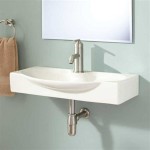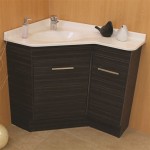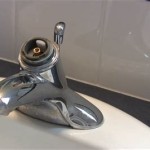Cost To Install A New Bathroom Vanity: A Comprehensive Guide
Installing a new bathroom vanity can significantly enhance the aesthetic appeal and functionality of a bathroom. However, before embarking on this home improvement project, understanding the associated costs is crucial. The total expense can vary significantly based on several factors, including the type of vanity, materials, labor costs, and any necessary plumbing or electrical work. This article provides a detailed breakdown of the costs involved in installing a new bathroom vanity.
The purchase of the vanity unit itself represents a primary cost component. Bathroom vanities are available in a wide range of styles, sizes, and materials, directly impacting the price. Simple, pre-fabricated vanities made from laminate or MDF (Medium-Density Fiberboard) can be relatively inexpensive, while custom-built vanities constructed from solid hardwood with premium countertops will command a higher price. The size of the vanity, measured by its width and depth, also plays a significant role in determining the price. Larger vanities with more storage space will generally cost more than smaller, more compact models.
Beyond the unit itself, the costs associated with installation are equally important to consider. Professional installation often involves removing the old vanity, preparing the space for the new unit, plumbing connections for the sink and faucet, and potentially electrical work for lighting fixtures or outlets integrated into the vanity. These labor costs can fluctuate significantly based on the complexity of the installation, the geographic location, and the experience level of the hired professional. Homeowners should obtain multiple quotes from qualified contractors to ensure a competitive price.
Furthermore, additional expenses can arise if the installation requires modifications to existing plumbing or electrical systems. Moving plumbing lines or adding new electrical outlets can add substantially to the overall project cost. Therefore, a thorough assessment of the existing bathroom infrastructure is essential before proceeding with the installation.
Key Factors Influencing Vanity Costs
The material of the vanity plays a significant role in its cost. Common materials include laminate, MDF, solid wood, and various combinations thereof. Laminate vanities are often the most affordable option, offering a durable and water-resistant surface. However, they may lack the aesthetic appeal and longevity of solid wood vanities. MDF vanities are a mid-range option, providing a balance of affordability and durability. Solid wood vanities are the most expensive, offering superior quality, durability, and a timeless aesthetic. The type of wood used, such as oak, maple, or cherry, will also influence the price.
The countertop material is another important factor. Common countertop materials include laminate, solid surface (e.g., Corian), quartz, granite, and marble. Laminate countertops are the most affordable but may be less durable and scratch-resistant than other options. Solid surface countertops offer a seamless, non-porous surface that is easy to clean and maintain. Quartz countertops are a popular choice due to their durability, stain resistance, and wide range of colors and patterns. Granite and marble countertops are natural stone options that offer a luxurious look but require more maintenance and are more susceptible to staining.
The style of the vanity also contributes to the overall cost. Simple, basic vanities with minimal detailing are generally less expensive than more elaborate vanities with intricate carvings, custom hardware, or unique features. Floating vanities, which are mounted to the wall without legs, often require more labor to install and may therefore be more expensive. Antique or vintage-style vanities can also command a higher price due to their unique design and potential rarity.
Installation Labor Costs Breakdown
The labor costs associated with installing a new bathroom vanity can vary significantly depending on the scope of the project and the hourly rate of the hired professional. A basic vanity installation, which involves removing the old vanity, connecting the plumbing, and securing the new vanity to the wall, may take anywhere from 4 to 8 hours to complete. The hourly rate for a plumber or general contractor can range from $50 to $150 or more, depending on the geographic location and their experience level. Therefore, the labor cost for a basic installation could range from $200 to $1200.
However, if the installation requires additional work, such as moving plumbing lines or adding new electrical outlets, the labor costs will increase accordingly. Moving plumbing lines can be a complex task that requires specialized skills and may take several hours to complete. Adding new electrical outlets may also require the services of a licensed electrician, which can add to the overall cost. The cost of these additional services can vary widely depending on the complexity of the work and the rates charged by the plumbing and electrical professionals.
Furthermore, the removal and disposal of the old vanity can also incur additional costs. Some contractors include the disposal of the old vanity in their installation fee, while others may charge an additional fee for this service. Homeowners can also choose to dispose of the old vanity themselves, but this may require renting a truck or trailer and paying disposal fees at a local landfill.
It's essential to obtain detailed written estimates from multiple contractors before hiring someone to install a new bathroom vanity. The estimate should clearly outline the scope of the work, the materials to be used, the labor costs, and any additional fees. Homeowners should also verify that the contractor is licensed and insured to protect themselves from liability in case of accidents or damages during the installation process.
Additional Costs to Consider
Beyond the vanity unit and installation labor, several other potential costs should be factored into the overall budget. These costs may include: Faucets and sinks, if these are not included with the vanity purchase; Plumbing supplies, such as supply lines, drain pipes, and sealant; Electrical supplies if new wiring or outlets are required; New lighting fixtures if the existing fixtures are not compatible with the new vanity; Wall repairs if the removal of the old vanity causes damage to the wall; Painting or wallpapering if the wall needs to be repainted or re-wallpapered after the installation; Permits if required by local building codes.
The cost of faucets and sinks can vary widely depending on the style, material, and brand. Basic faucets and sinks can be relatively inexpensive, while high-end models with advanced features can cost several hundred dollars or more. Similarly, the cost of plumbing and electrical supplies can vary depending on the complexity of the installation and the quality of the materials used.
Wall repairs and painting or wallpapering can be necessary if the removal of the old vanity causes damage to the wall or if the new vanity exposes areas of the wall that were previously hidden. These additional costs can add significantly to the overall project budget, so it's essential to inspect the wall carefully before starting the installation and factor in these potential expenses.
Local building codes may require permits for certain types of bathroom renovations, including vanity installations. The cost of permits can vary depending on the location and the scope of the project. It's important to check with the local building department to determine if any permits are required before starting the installation.
In summary, installing a new bathroom vanity involves a range of costs, including the purchase of the vanity unit, installation labor, and potential additional expenses. By carefully considering all of these factors and obtaining detailed estimates from qualified professionals, homeowners can accurately budget for the project and avoid unexpected costs.
Choosing the right vanity style, material, and size is important. Considering the bathroom's overall decor and the required storage space, homeowners should opt for vanities that complement the space and fit the needs. Careful planning and budgeting are crucial steps toward ensuring a successful installation.
Ultimately, a new bathroom vanity can significantly improve a bathroom's functionality and aesthetic appeal. With careful planning and budgeting, homeowners can achieve their desired results within a reasonable price range. Taking the time to investigate all the aspects of vanity installation will help in making informed decisions and in achieving long-lasting satisfaction.

Bathroom Vanity Installation Cost 2024 Average S

How Much Does It Cost To Install A Bathroom Vanity 2024 Bob Vila

2024 Vanity Installation Cost A Complete Guide

Bathroom Vanity Replacement Cost Interunet

How Much Does Bathroom Vanity Installation Cost 2024

Fixr Com Bathroom Sink Cost To Replace

2024 Cost To Replace Bathroom Countertop A Guide

How Much Does Bathroom Vanity Installation Cost 2024

Fixr Com Sink Installation Cost New

How Much Does A New Bathroom Cost In 2024 Victoriaplum Com
Related Posts







